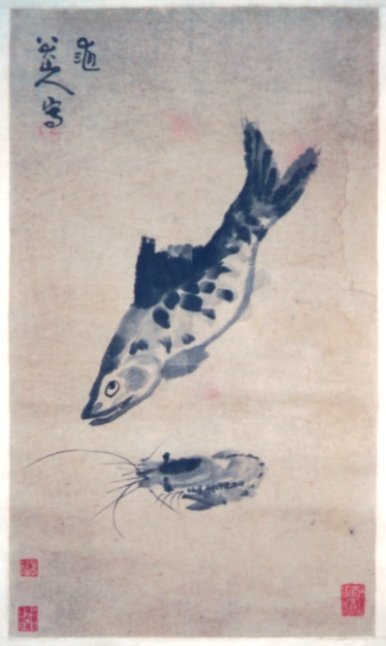

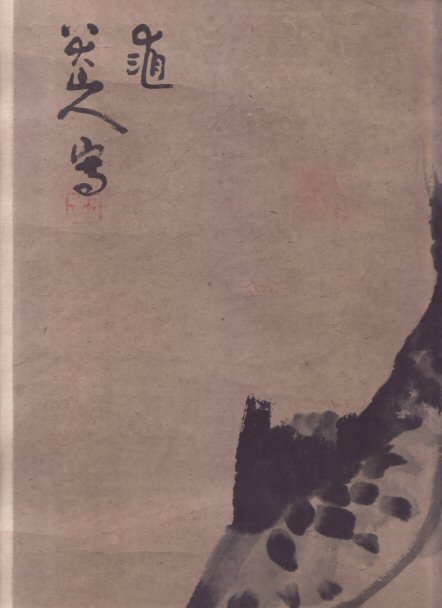
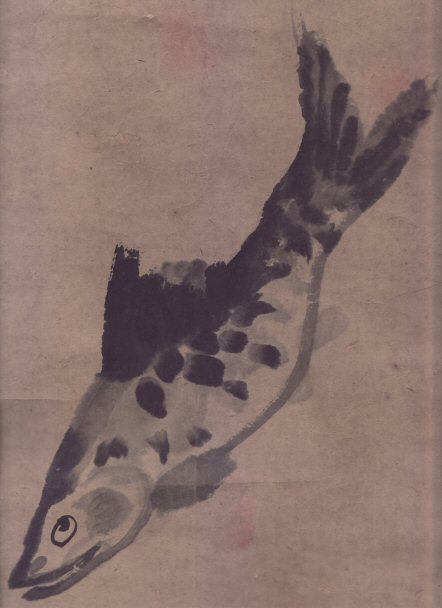
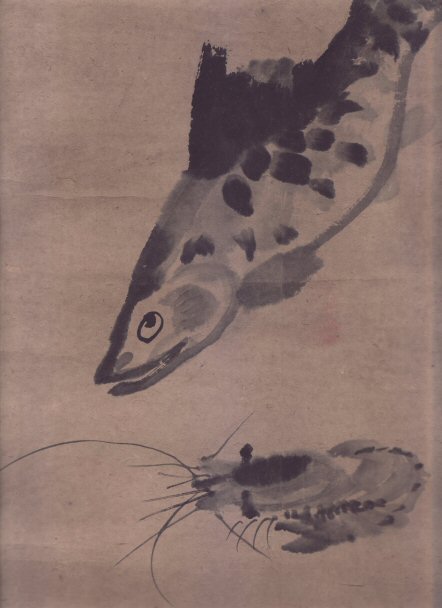
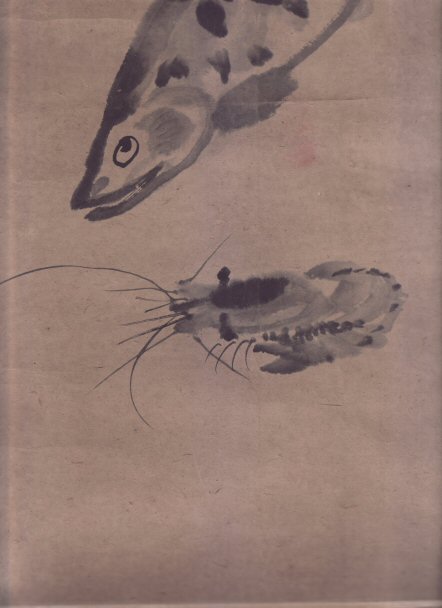
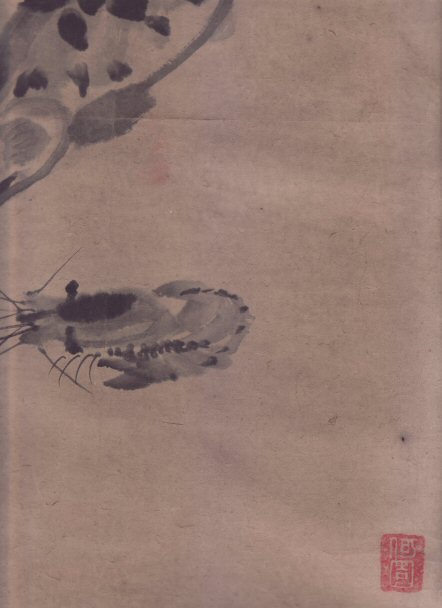
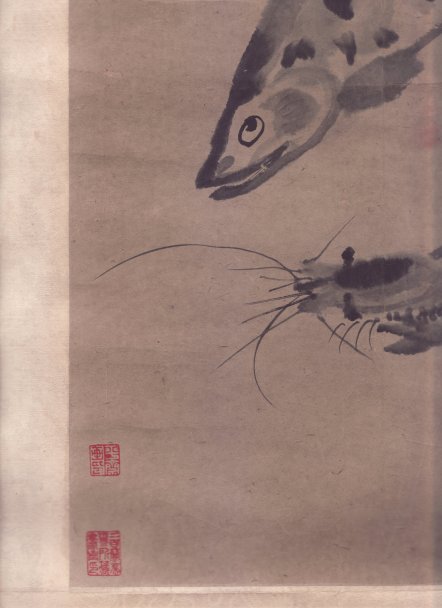
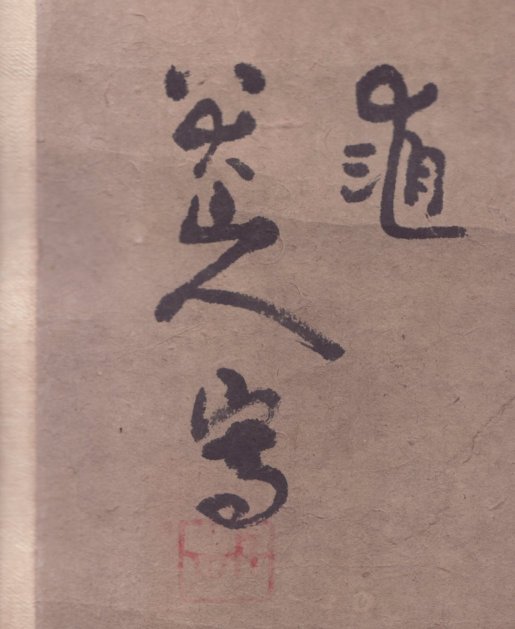
Fish and Shrimp Painting by Qing Dynasty Master Ba Da Shan-ren (Zhu Da) (1626-1705)
清代大書畫家朱耷(八大山人) (1626-1705) 魚蝦畫
Zhu Da [Chu Ta; Chuanqi; hao Bada Shanren, Pa-ta Shan-jen]
(b 1626, Nanchang, Jiangxi Province; d 1705).
Chinese painter and poet. A descendant of the imperial Zhu family of the Ming dynasty (1368–1644) and a leading artist of the early Qing period (1644–1911), Zhu Da painted flowers, birds and landscapes in a distinctive and highly dramatic calligraphic style. His connections with the previous dynasty led him to flee Nanchang after the Manchu conquest of China in 1644. Adopting the sobriquet Chuanqi, Zhu Da became a Buddhist priest and soon a respected Buddhist master, quickly attaining the position of abbot. He also became an accomplished poet and painter; his earliest extant work is an album of 15 leaves (1659; Taipei, National Palace Museum). In 1672, after the death of his Buddhist master, Abbot Hong min, Zhu Da relinquished his solitary monastic existence to pursue his fortune as an itinerant monk-artist. He joined the coterie of Hu Yitang, magistrate of Linchuan County, and participated in the splendid poetry parties held in 1679 and 1680. Zhu Da was thwarted in his attempts to take up an official career because of his imperial lineage and in 1680 was devastated by the departure of his patron Hu Yitang. Reportedly, Zhu Da went mad; one day, laughing and crying uncontrollably, he tore off his priest’s robe and set it on fire. The burning of the robe signaled the end of Zhu Da’s life as a Buddhist monk, and from then on he lived as an itinerant painter. Between 1681 and 1684 he called himself Lu (‘donkey’ or ‘ass’), a derogatory name for monks, or Lu hu (‘donkey house’); from 1684 onwards he called himself Bada Shanren (‘Mountain man of eight greatnesses’). Zhu Da adopted other names throughout his life, many reflecting his state of mind or his loyalty to the Ming dynasty. Of these, only a few (such as Chuanqi, which identifies his earliest extant work) were used as signatures, the most common being Bada Shanren.
Zhu Da developed a school of freehand brushwork in traditional Chinese painting and became an outstanding painter and Taoism believer. The individualism of his ink paintings of flowers, birds, fish, and landscapes appealed to the Japanese, and his style has become synonymous with Zen painting in Japan. There is an Art Gallery of Bada Shanren in a southern suburb of Nanchang. The gallery was once a Taoist temple called Qingyunpu and legend says that 2,500 years ago Qiao, son of Emperor Ling of the Zhou dynasty (1100-221BC) came here to seek a way to produce pills that would make him immortal.
Ba Da Shan Ren (1626-1705)
In paragone con la pittura occidentale, la pittura cinese ha la propria peculiare tecnica e i propri stili. Dal punto di vista tecnico, la pittura tradizionale cinese e` divisa in due scuole: quella di stile preciso e meticoloso che descrive verossimilmente col pennello i panorami e gli oggetti, e quella di stile libero impressionistico che con pennellate piu` grosse e piu` semplici descrive le espressioni e le forme delle cose, esprimendo le idee e il gusto dell’autore. Il maggiore rappresentante di questa scuola e` il famoso pittore di nome Ba Da Shan Ren, vissuto nel 17° secolo.
Ba Da Shan Ren, che si chiamava originalmente Zhu Da, nacque nel 1626. Egli era discendente di Zhu Yuanzhang, primo imperatore della dinastia Ming (meta` del 14° secolo). All’eta` di 19 anni, nel 1644, la dinastia Ming fu rovesciata. Ostile alla dinastia Qing, Ba Da Shan Ren abbandono` la famiglia e divenne un monaco, vivendo in reclusione nel monastero di Nanchang. Si dedico` alla calligrafia e alla pittura ed ottene grandi successi nel campo artistico e diventando un grande maestro la cui fama usci` fuori della Cina.
Ba Da Shan Ren eredito` le
migliori tradizioni dei pittori delle precedenti generazioni e
creo` anche il proprio stile. Nel confronto tra le forze
riformiste e quelle conservatrici nella pittura del tempo, egli
appartenne alla prima e porto` ad una nuova altezza la pittura di
stile libero impressionistico. Tra le sue opere, i dipinti di
fiori e di uccelli furono i piu` apprezzati. Rispondendo al gusto
dell’epoca e alle sue esperienze personali, utilizzo` spesso l’allegoria
per esprimere i suoi sentimenti in forma artistica. Dalle pitture
esposte possiamo notare che gli uccelli da lui dipinti stanno
spesso su una zampa, hanno ventre gonfio e il dorso curvo e lo
sguardo verso il cielo. Con questo egli esprime la sua
indignazione verso la Corte dei Qing e il suo spirito
inflessibile. Egli ha dipinto molti pesci vivaci e uccelli in
volo, boschi di pini vigorosi e forti, tutti trattegiati in modo
vivo. Egli e` riuscito sempre a raggiungere l’apice della “unione
della forma e dello spirito” in poche pennellate. Egli ebbe una
grande influenza sulla pittura per oltre 300 anni.
Il monastero taoista Qing Yun Pu di Nanchang dove visse Ba Da
Shan Ren, restaurato dopo la fondazione della nuova Cina, e`
diventato un museo. Dentro il museo ci sono otto sale d’esposizione.
Ora e` aperto per tutto l’anno per far ammirare le sue opere ai
visitatori. In fondo a un sentiero di bambu`, vicino ad uno
stagno pieno di fiori di loto, vi e` la tomba del pittore
nascosta tra alberi antichi e rigogliosi. La statua di bronzo del
pittore e` immersa in un mare di fiori e di piante, suscitando
rispetto e ammirazione tra i visitatori cinesi e stranieri, i
quali lo ricordano per le preziose eredita` artistiche lasciate
all’umanita`.
朱耷 (八大山人) (1626-1705)
即朱耷。清初畫家,譜名統 ,南昌(今屬江西)人。明朝皇族江甯獻王朱權第九世孫。19歲時國破家亡,心情悲憤,便裝啞扮傻,在門上貼個大啞字,不與人語。23歲在奉新山出家為僧,并在耕庵老人處受戒。後又返俗,不久又做道士,在南昌建青雲譜道院。由於長期積憂抑鬱,遂患顛狂之疾,顛態百出。所書名號八大山人,必聯綴似哭之或笑之的字樣,蓋意別有在。
工書法,行楷學王獻之,純樸圓潤,無明人習氣。狂草亦怪偉,自成一家。尤擅繪畫。山水學黃公望。在構圖上頗受董其昌影響,但用筆乾枯,一片荒涼氣象。花鳥在沈周、陳淳、徐渭水墨花鳥基礎上,樹立特殊風格,簡單奇異,不落恆蹊,而用筆用墨,於豪放中有溫雅,於單鈍中有含蓄,能用極少筆墨表現極複雜事物,與石濤畫風異曲同工,影響於清代花鳥畫極大。畫鳥只畫一足,畫眼則眼珠向上,所謂白眼看青天,以寓其不平之氣。其畫作甚為日人尊崇, 奉為禪畫宗師。存畫印本很多。
[朱氏八支宗譜、國(清)朝畫徵錄、青門剩稿、清畫家詩史、書林紀事、辭海]
款識特點
八大山人的字、號、別名特別多,他原名統 ,又名朱耷,號八大山人、雪個、個山、人屋、驢漢、驢屋驢、個山驢、刃菴、道朗、人屋、良月、破雲樵等。後做道士,居“表雲譜”。入清後隱其姓名,削髮為僧時取法名傳綮,字刃庵,用到康熙庚甲(1680年)55歲。號雪個始於41歲,用到55歲。號個山始見於46歲,直到59歲,他還有驢、驢屋、人屋等號,驢 款最早見於56歲,最晚是58歲。人屋、驢屋同時使用,60歲以前使用的字,號尚有法堀、掣顛、純漢、綮雪衲、臥屋子、弘選等。朱耷為僧名,“耷”乃“驢”字的俗寫,至於八大山人號,乃是他棄僧還俗後所取,始自59歲,直至80歲去世,以前的字均棄而不用。所書“八大山人”含意深刻,“八大”與“山人”緊聯起來,即“類哭之、笑之”作為他那隱痛的寄意,他有詩“無聊笑哭漫流傳”之句,以表達故國淪亡,哭笑不得的心情。
藝術特色
八大山人善畫山水和花鳥。他的畫,筆情恣縱,不構成法,蒼勁圓秀,逸氣橫生,章法不求完整而得完整。他的一花一鳥不是盤算多少、大小,而是著眼於佈置上的地位與氣勢。及是否用得適時,用得出奇,用得巧妙。這就是他的三者取勝法,如在繪畫佈局上發現有不足之處,有時用款書雲補其意。八大山人能詩,書法精妙,所以他的畫即使畫得不多,有了他的題詩,意境就充足了,他的畫,使人感到小而不少,這就是藝術上的巧妙。
他的山水畫多為水墨,宗法董其昌,兼取黃公望,倪瓚、他用董其昌的筆法來畫山水,卻絕無秀逸平和,明潔幽雅的格調,而是枯索冷寂,滿目淒涼,於荒寂境界中透出雄健簡樸之氣,反映了他孤憤的心境和堅毅的個性。他的用墨不同于董其昌,董其昌淡毫而得滋潤明潔,八大山人幹擦而能滋潤明潔。所以在畫上同是“奔放”,八大山人與別人放得不一樣,同是“滋潤”,八大山人與別人潤得不一樣。一個畫家,在藝術上的表現,能夠既不同於前人,又于時人所不及。 他的花鳥畫成就特別突出,也最有個性。其畫大多緣物抒情,用象徵手法表達寓意,將物象人格化,寄託自己的感情。如畫魚、鳥,曾作“白眼向人”之狀,抒發憤世嫉俗之情。其花鳥畫風,可分為三個時期,50歲以前為僧時屬早期,署款“傳綮”、“個山”、“驢” 、“人屋”,多繪蔬果、花卉、松梅一類題材,以卷冊為多。畫面比較精細工致,勁挺有力。50歲至65歲?中期,畫風逐漸變化,喜繪魚、鳥、草蟲、動物,形象有所誇張,用筆挺勁刻削,動物和鳥的嘴、眼多呈方形,面作卵形,上大下小,岌岌可危,禽鳥多棲一足,懸一足。65歲以後為晚期、藝術日趨成熟。筆勢變為朴茂雄偉,造型極為誇張,魚、鳥之眼一圈一點,眼珠頂著眼圈,一幅“白眼向天”的神情。他畫的鳥有些顯得很倔強,即使落墨不多,卻表現出鳥兒振羽,使人有不可一觸,觸之即飛的感覺。有些禽鳥拳足縮頸,一副既受欺又不屈的情態,在構圖、筆墨上也更加簡略。這些形象塑造,無疑是畫家自的寫照,即“憤慨悲歌,憂憤於世,一一寄情於筆墨”。他在題黃公望山水詩中寫道:“郭家皴法雲頭小,董老麻皮樹上多。想見時人解圖畫,一峰還與宋山河。表現出他的民族意識。
八大山人的畫在當時影響並不大,傳其法者僅牛石慧和萬個等人,但對後世繪畫影響是深遠的,他的藝術成就主要一點,不落常套,自有創造。他的大寫意,不同于徐渭,徐渭奔放而能放,八大山人嚴整而能放。清代中期的“楊州八怪”,晚期的“海派”以及現代的齊白石,張大千、潘天壽、李苦禪等巨匠,莫不受其熏陶。
作品行情
八大山人的繪畫不易摹仿,傳世作品不多,目前海外市場很少能見到八大山人作品,由於他在美術史上佔有極重要的地位,一般收藏八大山人作品的公私博物院也不會輕易出售。現在見到出售的作品只有4件,1990年11月紐約佳士得拍賣行拍賣過一幅《貓石圖》軸,水墨紙本,以1.8萬美元成交。1991年5月29日紐約蘇富比拍賣行拍賣過兩幅,一幅是行書《愛蓮說》,金紙本立軸,以1.32萬美元成交,另一幅是《荷花》軸,紙本,拍到34萬美元。1991年11月26日,紐約佳士得又拍賣他一件精品《花鳥冊》,價格達到55萬美元。
The special symbol
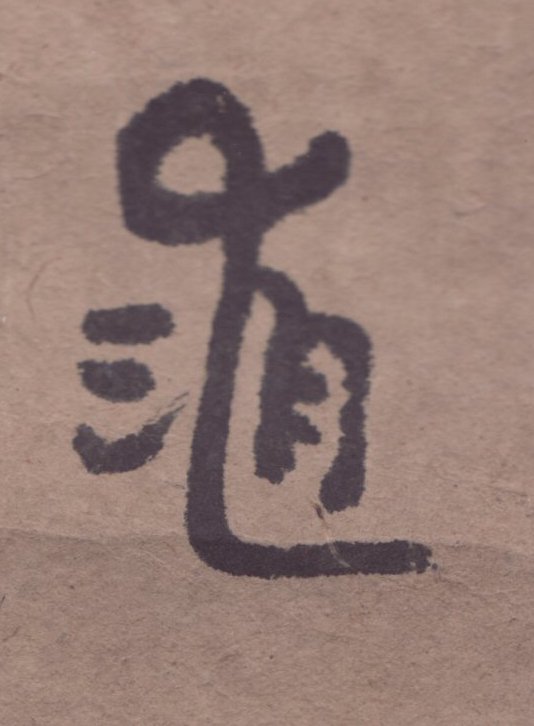 by
the side of the signature is said to be a memorial of the date (March 19) when
the last emperor of the Ming Dynasty hanged himself on a tree on a mountain.
by
the side of the signature is said to be a memorial of the date (March 19) when
the last emperor of the Ming Dynasty hanged himself on a tree on a mountain.
在簽名右上側之畫押
 據說作為悼念甲申三月十九日,崇禎帝吊死煤山而明朝滅亡之日,畫押是以“三月十九”四字組成。
據說作為悼念甲申三月十九日,崇禎帝吊死煤山而明朝滅亡之日,畫押是以“三月十九”四字組成。
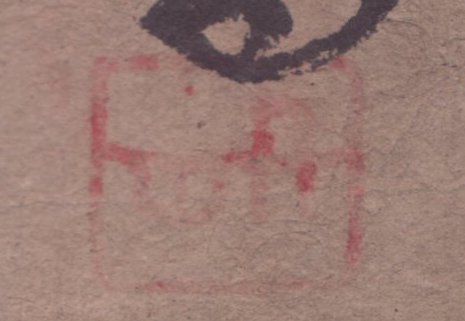
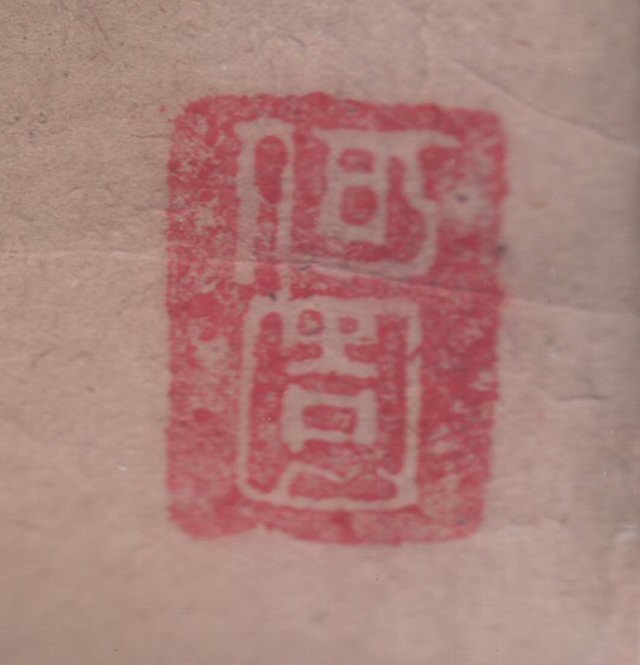
以上 [個山] 和 [何園] 兩個印是八大山人常用印章。
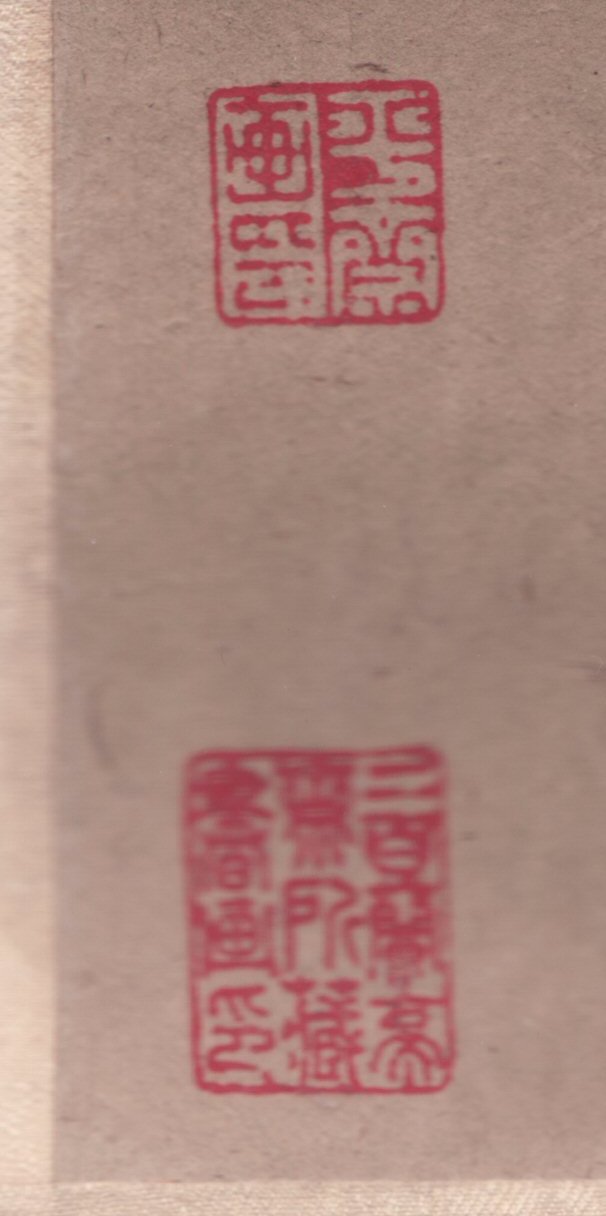
The above two seals are the collector's seals of Wu Yun (1811-1883), a late Qing Dynasty collector.
以上 [平齋畫印] 和 [二百蘭亭齋] 兩個印是清代收藏家吳雲印章。
吳雲(1811-1883),字少青,一作少甫,號平齋,晚號退樓,又號愉庭,別署醉石、二百蘭亭齋等,浙江湖州人。一作歸安(今浙江湖州)人。舉人,官蘇州知府。好古精鑒,性喜金石彝鼎,法書名畫,漢印晉磚,宋元書籍,一一羅致。所藏齊侯罍二,王羲之蘭亭序二百種,最為珍秘。著兩罍軒彝器圖釋、金石三種,親自繪圖,尤為可貴。書法顏真卿,刻印澤古功深,迥出凡近。偶寫山水、花鳥,隨意點染,脫盡恒蹊。卒年七十三。
Click at the Images Below to See Other Paintings of this Painter in the Collection